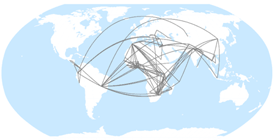The existing evidence from both cross-country and country case studies on the determinants of foreign bank entry and on the impact of foreign banks on host economies suggests the brick-and-mortar operations of international banks have important implications for competition and efficiency of the local financial sectors and for financial stability and access to credit in the host country (World Bank, 2018). The Global Financial Development Report 2017/2018: Bankers without Borders contributes to the policy dialogue on international banks by summarizing what has been learned so far about: i) the risks and opportunities posed by foreign banks when entering developing countries and ii) under what circumstances host economies can reap most benefits from the entry of international banks.
One key message from the report is that foreign banks, through their brick and mortar operations, can improve the performance of local banks, increase competition in the banking sector and raise overall credit access in the host economy. However, for these benefits to materialize, host and home countries need to have in place the proper regulatory and supervisory frameworks, and the entry of foreign banks must be accompanied by institutional and legal reforms that strengthen the information environment and contract enforcement of the host economy.
In other words, the impact that foreign banks can have on the overall access to credit and development of the local banking sector is greatly dependent on host country factors. Under proper conditions, foreign banks could bring superior technology, better supervision practices, or larger economies of scale to host economies that may materialize in increased access to credit and a more developed financial sector. However, if the cost of acquiring information about new clients is too high for foreign banks (e.g., due to a poor contract enforcement or information environment), they may concentrate their lending on the largest, safest firms. Overall access to credit may be reduced if local banks find themselves unable to compete effectively with the entering foreign banks. In that case, foreign banks could not only limit their lending to the largest customers but also, by their entry, could force some domestic banks out of the market.
In terms of financial stability, the evidence overwhelmingly shows that while foreign banks can help host countries through local financial crises (by for example smoothing credit flows), they also can import shocks from abroad (Cull and Martínez Pería 2013; Morais et al., forthcoming; Schnabl 2012). The propagation of shocks can be minimized through cross-border cooperation between authorities from home and host countries. In addition, host economies can better manage the propagation of shocks by allowing the entry of foreign banks from home countries with stricter bank regulations, or by diversifying the roster of foreign banks by home country (to mitigate the impact of shocks from a specific country).
This last point brings us to the discussion of the composition of foreign banks, which has been evolving rapidly and can have important implications for access to credit and stability. Regionalization in the roster of foreign banks as well as South-South bank entry have been on the rise since the global financial crisis (figure 1). These new foreign banks are likely better suited to serve smaller and more informationally opaque segments, such as SMEs and households, since they are more familiar with the institutions and the culture of host developing countries. For stability however, to the extent shocks are more correlated within regions than they are globally, greater regionalization can limit risk sharing. Moreover, foreign banks from less regulated and institutionally weaker home countries may pose additional risks to the host economy. Because these trends are relatively recent, the net effects of regionalization and South-South banking are not yet fully clear.
| Figure 1. South-South Banking Subsidiary Networks, 2005 and 2014 | |
| Panel a. Networks in 2005 | Panel b. Networks in 2014 |
 |
 |
| Note: Visualization based on Bertay, Demirgüç-Kunt, and Huizinga (2017). The maps show host developing countries of foreign bank subsidiaries and the home countries where those banks are headquartered. The connections reflect at least one foreign majority-owned subsidiary for each country pair. | |
On the topic of stability, cooperation between home and host countries needs to increase, as the years after the Global Financial Crisis showed that simply relying on international agreements and the exchange of information has not been enough: current cooperation arrangements give host country authorities limited ability to properly supervise international banks, and supervisors from home and host countries do not consider fully the effects of their decisions beyond their borders. Closer coordination of regulation and supervision is becoming even more relevant now, as the composition of players and new technologies in the finance area keep changing the industry.
Summing up, foreign banks on their own are no panacea for guaranteeing financial development and stability. The actions taken by host country authorities before and after the entry of foreign banks will largely determine the impact that foreign banks have on the host economy. Host countries should therefore work to create the conditions needed to reap the benefits of international banking. Regulators in developing countries should adopt a strong financial regulatory and supervisory framework, accompanied by institutional reforms, an improved information environment and contract enforcement that strengthen the local banking sector and thus help enable domestic banks to compete effectively with foreign banks (Demirgüç-Kunt, Beck, and Honohan 2008).
International banking and other related topics will be discussed in the upcoming Overview Course of Financial Sector Issues of the World Bank. Click here for information about the course and how to register.
References
Bertay, A. C., Demirgüç-Kunt, A., and Huizinga, H. 2013. “Do We Need Big Banks? Evidence on Performance, Strategy and Market Discipline.” Journal of Financial Intermediation 224: 532-558.
Cull, R. and Martinez Peria, M. S., 2013. “Bank Ownership and Lending Patterns during the 2008–2009 Financial Crisis: Evidence from Latin America and Eastern Europe.” Journal of Banking & Finance, 37(12): 4861-4878.
Demirgüç-Kunt, Asli, Thorsten Beck, and Patrick Honohan. 2008. “Finance for All? Policies and Pitfalls in Expanding Access.” World Bank, Washington, DC.
Morais, B., J. L. Peydró, Jessica Roldan and Claudia Ruiz Ortega. Forthcoming. “The International Bank Lending Channel of Monetary Policy Rates and Quantitative Easing: Credit Supply, Reach-for-yield, and Real Effects.” Journal of Finance.
Schnabl, P. 2012. “The International Transmission of Bank Liquidity Shocks: Evidence from An Emerging Market.” Journal of Finance 67(3): 897–932.
World Bank, 2018, Global Financial Development Report 2017/2018: Bankers without Borders. Washington DC: World Bank.



Join the Conversation